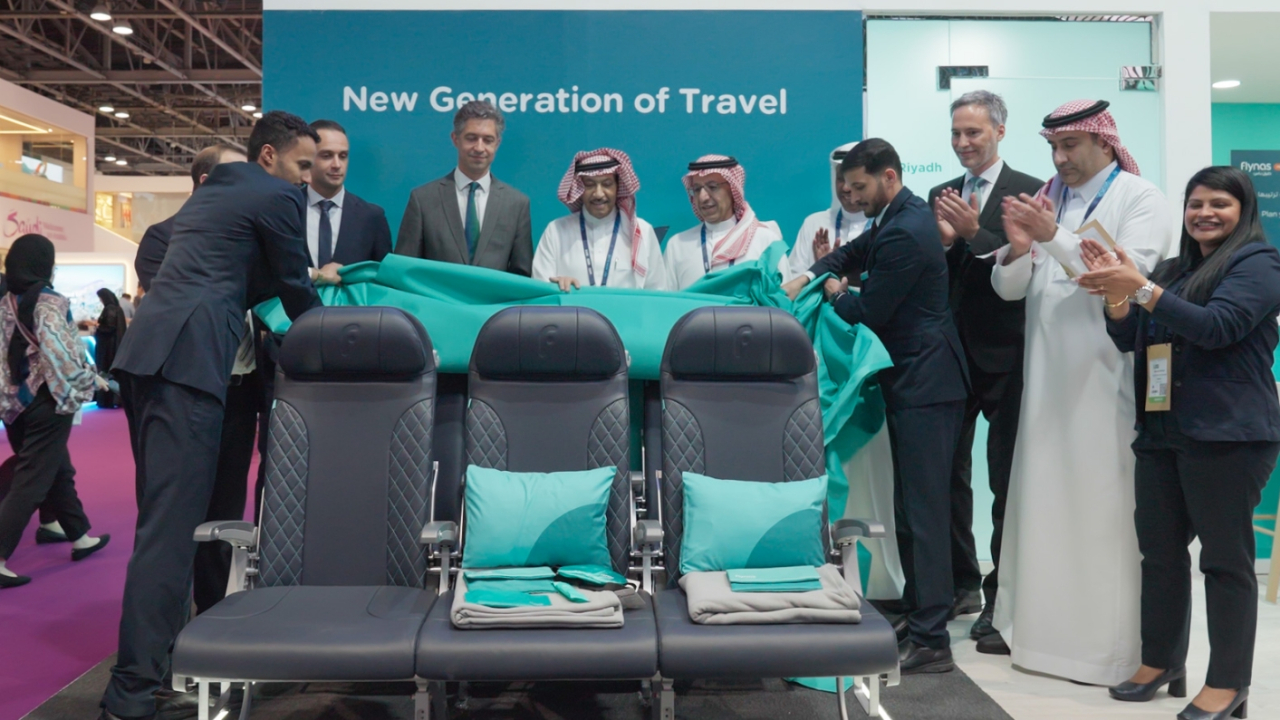Welcome to the cabin casbah

The latest passenger survey from respected monitoring company Skytrax ranks Qatar Airways, Emirates and Etihad among the best in the world for service quality, with the big names from Europe and North America nowhere to be seen.
And Emirates continues to roll out a unique offering, recently introducing its first-class showers on a second daily A380 frequency from Dubai to London.
The Middle East now sets the service standard for the rest of the air transport industry to follow and the world’s cabin system and product suppliers are keen to rise to the challenge. Nearly 50 of them came to Dubai in February for the second edition of Aircraft Interiors Middle East to show off the best they have to offer in the way of in-flight entertainment, connectivity, seating, interiors and furnishings.
Setting the tone was Emirates IFE/connectivity guru Patrick Brannelly, keynote speaker at the show’s first-day workshop. “The Middle East is a very good opportunity for vendors and events like this are a very good showcase,” he said. “I shall be looking for suppliers with a passion for innovation and excellence.”
When it comes to innovation, Emirates corporate communications VP Brannelly knows what he’s talking about. In his previous job as passenger communications and visual services VP he drove many of the new amenities enjoyed by the airline’s customers, including the industry-leading ICE in-flight entertainment service and the world’s first onboard mobile phone service. Introduced in March 2008, phone capability is now available on more than 70 Emirates aircraft and is being rolled out to the rest of the fleet.
In just under two years 1.6 million passengers have logged on to the service, which has been offered on more than 55,000 flights. Around a quarter-of-a-million text messages have been sent from Emirates aircraft this year alone. “Sooner or later the whole debate over connectivity in aircraft will be over,” Brannelly said. “The only question is when, not if.”
He looked forward to the imminent addition of BlackBerry connectivity to the service, asserting that hard times were no reason for a company to back off from innovation. “There are real, pressing reasons for innovation,” he declared. “To begin with, the passenger goes ‘Wow’ at the latest offering. Then as time passes it becomes ordinary and people want something newer and better. For example, today’s business-class traveller wants more than was offered in first-class ten years ago.”
Among the innovators who caught the eye at AIME were seat makers EADS Sogerma, Recaro and Aviointeriors, two new-generation IFE system suppliers – AlsterAero of Hamburg, and Californian-based The IMS Company – and IFE market leader and emerging connectivity player Panasonic.
“We decided it was time we offered a first-class suite of the highest quality,” said EADS Sogerma sales and marketing VP Jeff Forsbrey. The result is Ultimate 17, which made its public debut at the French seat maker’s stand.
“We unveiled it here because the Middle Eastern market is very important to us,” Forsbrey said. “We have several existing and potential customers in the region and they all value the highest possible levels of quality and comfort. This seat is designed to meet those needs in full.”
Ultimate 17 is now in series production at Sogerma’s facility in Rochefort, south-west France, against orders from several airline customers.
The wraps will come off further new developments from Sogerma at Aircraft Interiors Expo in Hamburg later this year. “We plan to show our Ultimate Sleeper – Ultimate 17 plus a plug-in bed module,” Forsbrey said. “And visitors are welcome to come and see us about other new products that we’re working on.”
Ultimate Sleeper is the result of a collaboration between Sogerma and Lufthansa Technik. The Hamburg-based MRO and cabin systems provider came up with the original concept for an add-on bed and partnered with Sogerma to industrialise it and carry out series production.
To date Germany’s Recaro has focused successfully on the economy and business markets. “Now, as some carriers withdraw from the first-class market, we’re turning our attention to developing a design that will appeal to the two-class operators,” said regional sales director Kay Follath. “It will be a hybrid business/first-class seat combining fully lie-flat capability with more features than are usually found in a conventional first-class product.”
The company, which received a Crystal Cabin Award in 2009, was making its first appearance at AIME. “We’re at this show because in this region there’s a constant need to be present,” said Follath. “But we’re already strong in the Middle East and have negotiations under way with potential new customers.”
Existing Recaro clients in the region include FlyDubai, Qatar Airways, Saudi Arabian Airlines, Etihad and Gulf Air.
Low-fare operator FlyDubai has ordered the company’s BL3510 lightweight economy seat for the six Boeing 737-800s it has in service, with three more due to arrive by June.
Qatar Airways is the launch customer for the revolutionary new CL3620, designed to ease the pain of long-haul flights in economy. Derived from the established CL3610, it weighs less and offers what the company describes as exceptional legroom. Like its predecessor, it is based on a single-beam structure designed to replace the two support beams of conventional designs and so provide extra space for the passenger.
“The Comfort Line 3620 sets new standards in ergonomics,” said chief executive Axel Kahsnitz,. “It offers passengers exceptional comfort in the economy class. It is based on the unique single-beam principle that gives the seat a much leaner profile. This significantly increases legroom and lets passengers enjoy maximum living space – even with a relatively short seat pitch. Features like the flexible material in the headrest, the foot net, the ultra-thin backrest and other innovations add up to an exceptionally comfortable experience for passengers.”
Qatar has ordered the seat, along with the CL4420 business product, for 20 new Airbus A320s and four A321s.
Qantas and V-Australia have also ordered the CL3620.
Saudi Arabian Airlines has ordered CL4420 along with the CL3510 economy product for eight new Airbus A330-300s, while Etihad plans to retrofit the same combination to a total of ten A319s and A320s. Gulf Air has selected CL3510 and the CL4400 business unit for 15 A320s, with further aircraft on option.
Appealing to the very top end of the market was Aviointeriors. The Italian company showcased “beyond first-class” comfort in the form of its completely enclosed Sky Suite. “It’s a personal space where passengers can feel like they are in a luxury hotel suite,” said sales manager Christian Battisti.
With a pair of VIP installations already to its credit, Hamburg-based IFE system provider AlsterAero was at AIME to talk to completions centres and the airlines. “Our combined IFE/communications system is installed, certificated and flying in an Airbus A318 and an A319,” said managing director sales Bettina Mühlenberg-Lange. “And we’re talking to a number of full-service airlines about retrofits in their existing fleets.”
The brainchild of some former Luthansa Technik employees, AlsterAero has a staff of just 15 people. This small team has come up with a package that has attracted the praise of Airbus cabin specialists for its combination of versatility, performance and compactness.
The complete AlsterAero offering comprises passenger communications and IFE sub-systems and a cabin management capability. Customers can opt for all three, or for one or two of them. The data backbone is ethernet arranged in a tree structure designed to minimise cable runs. Flexible connection schemes and power transmission via the data cabling further simplify installation and have allowed the elimination of traditional seat electronic boxes.
The passenger communications capability is based on the all-digital IPTCU (IP cabin telecommunications unit) server and the ethernet switch, which together can support Inmarsat and other satellite bearer systems and applications such as wired and wireless Internet and VPN access, VoIP to cordless handsets, and ISDN data.
The IFE sub-system centres on a cluster of 2MCU servers, each capable of delivering audio, video, moving-map, games and other content to up to 50 seats. The AlsterAero architecture also makes possible less ambitious installations based on a DVD drive distributing its content over the same digital network. Any subsequent upgrade to a server-based arrangement is straightforward, according to the company.
The IMS company is also looking to break the
“Our Reliable Audio Video Entertainment (RAVE) does away with all the snags and bottlenecks typical of conventional AVOD architectures,” said Neil Morgan, the company’s director of sales for Europe, the Middle East and Africa. “It speeds and simplifies content loading, and is far more failure-tolerant – very important when passengers can judge a big part of their travel experience by the quality of the IFE.”
Announced last year and due for commercial availability in the next few months, the RAVE in-seat unit slots into the seatback, where it receives power and content via aircraft systems, and can be removed only by the cabin staff. Loaded with its full content set from a small (4MCU) head-end by a combination of cable and wireless, the unit is fully autonomous. If it fails, it can be replaced by a cabin attendant while normal service continues at every other seat.
RAVE comprises just two types of box – the seat display unit (SDU), which can also be configured as a crew control panel, and the head-end server (System Control Unit, SCU).
The SDU has an input for power and wired gigabit ethernet and wireless ports. The SCU, which acts as the aircraft interface as well as supplying content, is based on IMS’s successful Terminal Data Loader (TDL). The two units incorporate highly reliable solid-state storage, expandable from four to 12 terabytes, and there will be a choice of 8.5in, 10.6in, 12.1in and 15.4in screens.
AlsterAero and IMS are among the pack of young dogs snapping at the heels of Panasonic Avionics, represented at AIME by global communications services VP David Bruner. Panasonic effectively dominates the mainstream AVOD market with Thales Avionics and is now making a bid for similar pre-eminence in the passenger broadband connectivity arena.
The Californian-based company’s eXConnect Ku-band satellite service has been in development for a number of years but could now be close to its operational debut. “The first aircraft for our five eXConnect customers will be delivered by the end of the year,” said Bruner. “And you should look out for an announcement any time now from Lufthansa, our launch customer.”
According to Bruner, the German carrier plans to equip a significant number of aircraft before marketing the service, a successor to the pioneering Connexion by Boeing, to its passengers. “We will launch on the North Atlantic,” he said. “When we do, travellers on Lufthansa’s Europe-USA routes will be able to count on having it whenever they fly.”
Panasonic announced recently that eXConnect, along with the GSM phone and in-flight television elements of its Global Communications Suite, would be made available on the new Airbus A350. Bruner confirmed that offerability on the rest of the Airbus range was on its way.
AIME 2010 provided plenty of evidence that the Middle East’s appetite for cabin innovation has been little affected by the recession, while the vendors are only too happy to serve up the tastiest dishes they can prepare. This year’s event was a hearty meal – AIME 2012 could be a banquet.
Stay up to date
Subscribe to the free Times Aerospace newsletter and receive the latest content every week. We'll never share your email address.

